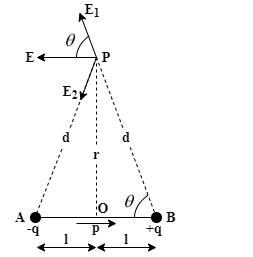Question
Question: Derive an expression for the electric field at a point on the equatorial plane of an electric dipole...
Derive an expression for the electric field at a point on the equatorial plane of an electric dipole.

Solution
Dipole is a pair of equal and opposite charges separated by some distance. Dipole moment of a dipole is the product of the charge with the separation distance between two opposite charges. To derive an electric field due to a dipole, first find the field for individual charges then take the resultant.
Formulae used:
Electric field at a distance d created due to a charge q is given by:
E=4πε1d2qd^............(1)
Where,
E denotes the electric field vector,
ε is permittivity of the medium,
d^ is the unit vector along the distance.
Dipole moment of a dipole is given by:
p=qL...................(2)
Where,
p denotes dipole moment,
q is the value of each charge,
L denotes the distance vector between the charges.
Complete step by step solution:
Step 1
Now, assume that the point is at a distance r away from the midpoint of the dipole. Also, take the distance between two charges as L=2l. Hence, you’ll get d as: d=r2+l2. Now, use these values in eq.(1) to get the electric field at P for the positive charge (+q) as:
E1=4πε1(r2+l2)2qd^=4πε1(r2+l2)qd^
Notice, the direction of the electric field is in the direction of the distance i.e. outward from the charge.
Step 2
Similarly, as you did above, now find the electric field at P due to the negative charge (-q) as:
E2=4πε1(r2+l2)2−qd^=−4πε1(r2+l2)qd^
Here, the negative sign implies that the direction of electric field is opposite to the direction of the distance i.e. inward to the charge.
Step 3
Now, both the electric fields are at an angle θ w.r.t horizontal line (see the figure). Hence, the resulting vertical component of E1 and E2 is given by:
EV=E1sinθ+E2sinθ =(4πε1(r2+l2)q−4πε1(r2+l2)q)sinθv^ =0
So, the resulting electric field will be in a horizontal direction.
Hence, the value of the resulting electric field will be:
E=EH=E1cosθ+E2cosθ.............(3)
Step 4
From the diagram we get, cosθ=r2+l2land using eq.(2) we get the value of dipole moment as: p=q×2l=2lq. Using these values in eq.(3) you’ll get:
And its direction will be horizontally from right to left direction (shown in figure).
